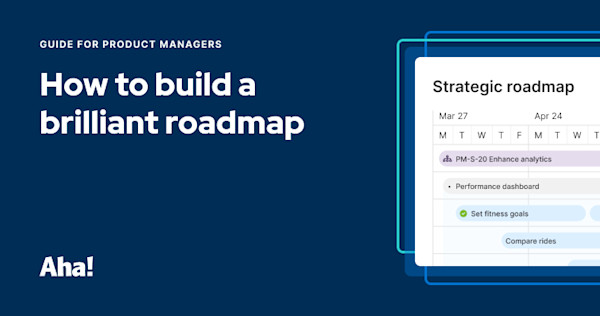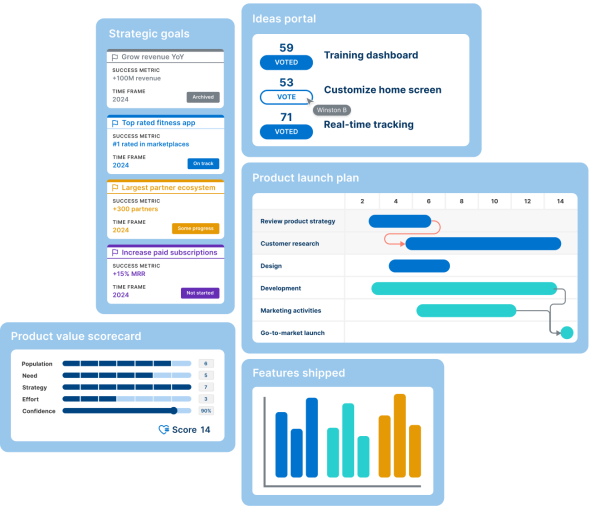Why are product roadmaps important?
Product managers depend on roadmaps for all kinds of scenarios. You could use a product roadmap to manage the launch of a new product, major enhancements to an existing one, or even updates to an internal application for the organization. If you need a reliable tool to help see your product plans through and reach your goals, a product roadmap is the way to go.
Creating and delivering a product is a herculean effort. It takes a serious commitment to your goals across the organization to pull it off well — from product management and product marketing to engineering. Your product roadmap is the best representation of this commitment. It is a promise to your team and your customers that you will be accountable to the most meaningful work.
The time to build your roadmap is when strategic product planning is done and the groundwork is laid for what you want to deliver and when. This is a big moment — you are at the start of a thrilling journey to deliver new value to your customers. Now you can build a product roadmap to chart your path forward.
Related:
The exercise of building a roadmap can be the impetus for conversations about where you will invest your efforts and why. When you connect your product strategy to implementation, you will always be able to trace the impact of your work with clarity.
Who is responsible for the product roadmap?
Product managers own the product roadmap. As a product manager, you lead the charge in collecting research, ideas, and feedback, translating and prioritizing these materials into features, and ultimately building the roadmap itself. Once it is built, you will share the roadmap and any progress with stakeholders. You also identify the right roadmaps to build for your team and when.
That said, the best product roadmaps involve cross-functional collaboration. Your work as a product manager impacts other groups, and you need their input and participation to deliver a Complete Product Experience (CPE). The roadmap is a central place to come together around your CPE — the visibility into what is coming next helps the entire organization prioritize and plan for the new experience you will deliver.
And the more inclusive your roadmapping process is, the greater organizational alignment and support you will have when you release that new experience. When you rally other teams around your product roadmap along the way, your product's success is a collective celebration.
Types of product roadmaps
Product roadmaps evolve. You should continuously adjust your roadmap throughout the lifecycle of your product based on shifting customer needs and market demand. Forward-thinking product managers see a product roadmap as a dynamic compass.
Because different teams will look for different things on your roadmap, you will likely want to create different views of it. Depending on your audience, you may choose from a few types of product roadmaps to clearly present the most relevant view. Each roadmap type shows similar information presented in a slightly different way — usually with varying degrees of specificity.
Here are five common types of product roadmaps and what makes each of them useful:
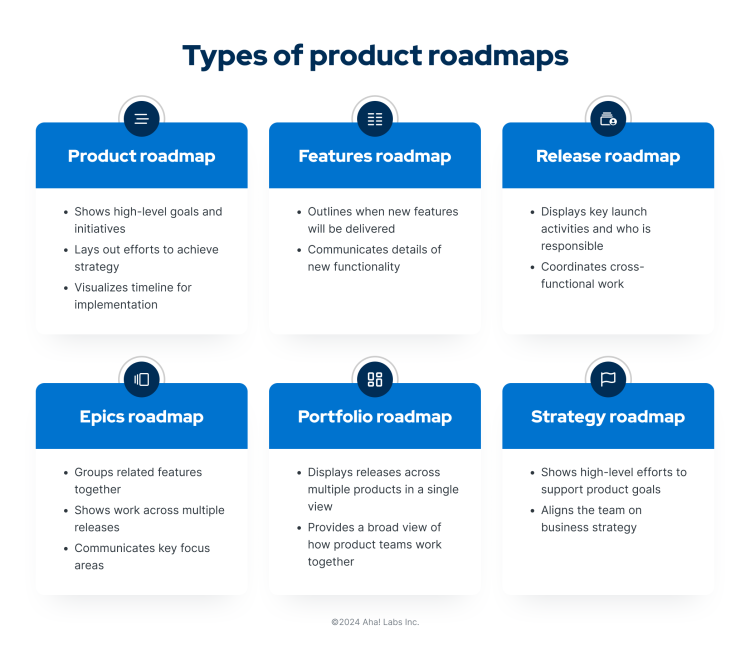
Epics roadmap | Helps you plan and organize upcoming work by grouping related features together. An epics roadmap is useful for visualizing work delivered across multiple releases, communicating key focus areas, and making prioritization decisions. |
Features roadmap | Shows the timeline for when new features will be delivered. Features roadmaps are perfect for communicating the details of what is coming and when to customers and other teams. |
Portfolio roadmap | Shows planned releases across multiple products in a single view. Portfolio roadmaps are useful for providing a strategic overview of your plan to leadership and a broad view of how multiple product teams work together. |
Release roadmap | Communicates the activities that must happen before you can bring releases to market — what needs to be done when and who is responsible for delivery. Release roadmaps are helpful for coordinating release activities with other cross-functional teams, such as marketing, sales, and customer support. |
Strategy roadmap | Displays the high-level efforts that you plan to invest in to achieve your product goals. A strategy roadmap is great for presenting progress on initiatives to leadership and keeping cross-functional teams aligned on overarching business strategy. |
Related: Examples of compelling roadmaps
Difference between product roadmaps and other terms
What is the difference between a product roadmap and the product vision? How does it compare to a release plan? If you are new to product development, it might sound as though these terms are referencing similar things. In reality each has a distinct definition and purpose. The table below will help you understand some of this commonly confused terminology:
Definition | Purpose | Scope | Who is responsible | |
Product roadmap | Tool for visualizing high-level strategy and plans | Communicate planned work to stakeholders | Entire product lifecycle | Product manager |
Product backlog | Dynamic list of prioritized features | Prioritize and manage upcoming functionality | Specific product increment | Product manager and product team |
Product vision | Long-term vision and goals for the product | Inspire and align stakeholders | Entire product direction | Product manager |
Project plan | Detailed plan for implementation | Manage project resources and timeline | Specific project | Project manager |
Release plan | Process of delivering new value to customers | Develop and launch a new product experience | Specific release | Product manager and product team |
Product roadmap templates
Product development teams vary in terms of sophistication and needs. You might be able to get going with static Excel roadmaps, especially early on. But when you are ready, you can use purpose-built tools to quickly create, customize, and share your roadmaps.
Many product teams use the product roadmap templates that are available in roadmapping software like Aha! Roadmaps — this is the best way to keep everyone aligned and your product roadmap automatically updated.
We also offer lightweight roadmaps as whiteboard templates. It can be useful to start your roadmap on a whiteboard and later convert elements from the board directly to features on your roadmap.
Start with the whiteboard template below — with a free trial.

We have also put together downloadable roadmap templates for you below. Adjust these to meet your needs.
Goals product roadmap Excel template
Use this product roadmap template to visualize high-level product goals. This view is helpful when you need to align the team on your product strategy and provide status updates to leadership.
Portfolio product roadmap Excel template
If you are managing multiple products, portfolio roadmaps display your planned releases for multiple products in a single view. This will give you a full picture of progress and help internal teams understand how their plans relate to one another.
Product release roadmap template
Product release roadmaps are convenient for displaying the key activities, like phases and milestones, that need to happen to deliver your product update to customers. For example, the release roadmap template below gives the team an easy way to visualize release plans as you prepare to launch a new experience to customers. You can show all the cross-functional activities the team needs to complete, along with the timeline for delivery — all in a single view.

Product feature roadmap template
A product feature roadmap shows your timeline for delivering new functionality to customers. This template is helpful for communicating a deeper level of detail than you will see on a release roadmap, including individual feature statuses.
Agile product roadmap template
In this agile product roadmap, swimlanes show how epics align with strategic themes. This roadmap view lets the engineering team see how their daily work relates to the big-picture plan.
Building a roadmap is a commendable stride toward product greatness. Moving forward, your product roadmap will be the best reflection of your progress and impact. Keep planning, collaborating, and updating your roadmap so that your work is always in motion and up-to-date.
How to approach creating a product roadmap
Building a product roadmap is complex and dynamic work. The process starts with strategy — you must establish the product goals and initiatives that your efforts will support. Once those are defined, you can decide which releases and features are best aligned with your strategy and then visualize it all on a timeline.
A few considerations will shape your roadmapping process. One is your audience — what you show on your roadmap depends on your intended viewers. In the table above, you saw how different types of roadmaps help to highlight different elements. As you build and customize your product roadmap, you can make additional decisions about which details to include (and which to leave out) so that the information portrayed is relevant to whoever is viewing it.
For example, the leadership team will want to understand the strategic importance of what you will deliver, conveyed through roll-up relationships between major releases and associated goals and initiatives. Your product marketing team, on the other hand, will be more concerned with the details and dependencies — so they can track and visualize moving pieces leading up to a product launch and coordinate all go-to-market plans accordingly.
Related:
You might share a version of your roadmap with customers too. Customers will want to see what is upcoming — especially any critical functionality they need. On a customer-facing roadmap, you might choose to show a broader release time frame instead of an exact date so that you have flexibility to shift if necessary.
Your product roadmap will also reflect the development methodology that your organization follows. For example, an agile team will create a product roadmap that is incremental and flexible to accommodate changes in customer needs and the market. But product roadmaps for organizations following a traditional waterfall approach will be more fixed — conveying a long-term commitment to building specific features within a given time frame.
Components of a product roadmap
The details and context may vary, but all product roadmaps should include a few key elements. Here is a quick overview of the main components you need:
Goals: Measurable, time-bound objectives with clearly defined success metrics. Goals represent the critical accomplishments needed to deliver your product.
Initiatives: High-level themes of work describing how your efforts will contribute to your goals. On a roadmap, initiatives show how specific releases and features relate to your strategy.
Releases: A launch of new product functionality represented on a timeline. Releases often contain multiple features that get delivered at the same time.
Epics: Larger bodies of work (like categories) that typically span multiple releases. Epics break down into smaller features that are delivered incrementally.
Features: A specific piece of new or improved functionality that results in value to users. Features can be related to capabilities, components, appearance, and performance.
Timeline: A visualization of when product releases will occur over time. The time scale can range anywhere from days to quarters or years depending on the amount of work and level of detail involved in a particular release.
5 essential steps for building your roadmap
With these components and considerations in mind, here are the five main steps to building an excellent product roadmap:
1. Define your product strategy
As mentioned above, setting strategic product goals and initiatives is an important first step in building a roadmap. Strategy is the "why" behind your product — it explains how your efforts will support the overall business. You will also need a strong product vision — capturing who your customers are, what they need, and how you will go to market with your offering. Together, the elements of your product strategy will inform everything that goes on your roadmap.
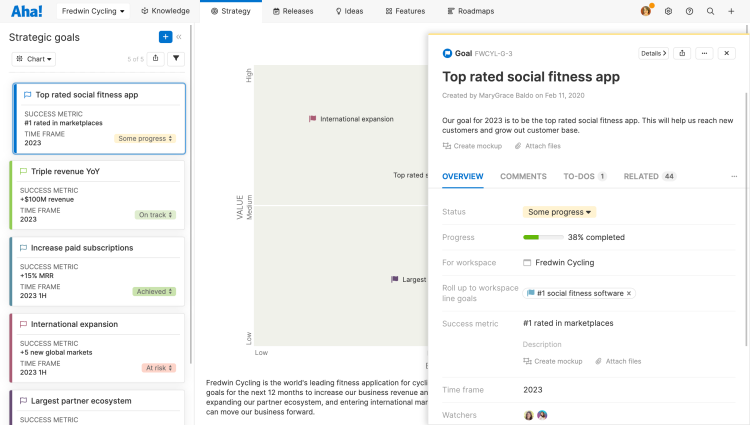
This is an example of strategic product goals in Aha! Roadmaps.
2. Review and manage ideas
Most product teams have a constant influx of product ideas from customers and customer-facing internal teams. When these ideas are organized and prioritized, they are valuable input for deciding what to put on your roadmap. For an objective method of idea evaluation, try scoring ideas based on metrics that reflect your strategy.
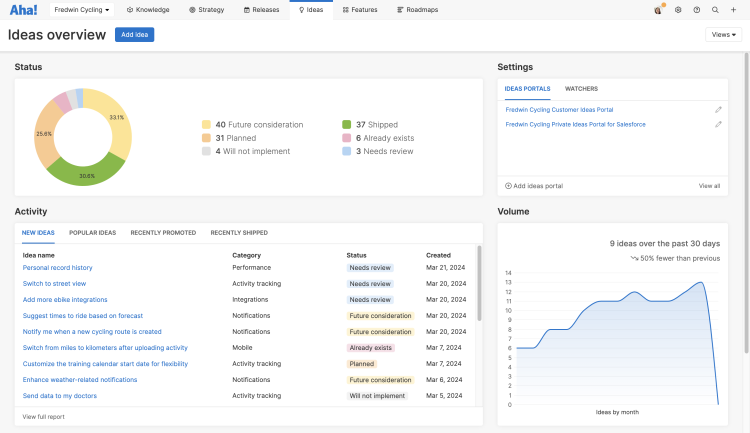
This is a real-time summary of customer ideas, as featured in Aha! Ideas.
3. Define features and requirements
This is when your product roadmap starts to take shape. With your goals, initiatives, and prioritized ideas to guide you, identify the specific product features that you want to deliver. Use a template or tool to put your features into words, add the necessary details in the requirements, and group related ones into epics (if needed). Anything valuable that does not fit on the first iteration of your product roadmap can be saved for later in your product backlog.
At this stage, you can also translate your features into user stories to describe the benefit from the customer's perspective. User stories give your engineering team the context they need to implement the best solutions.
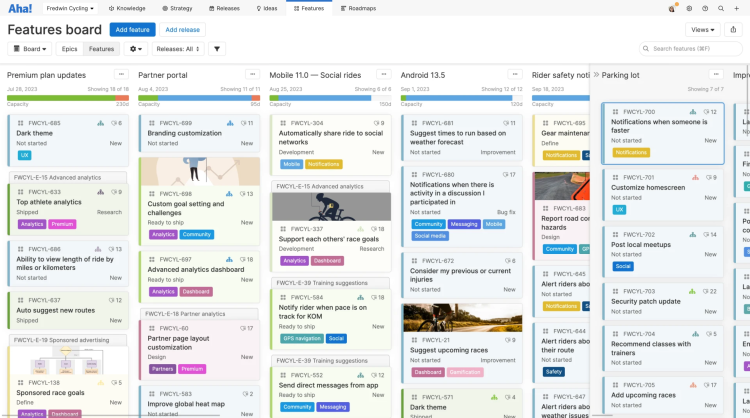
You can easily organize and categorize features Aha! Roadmaps.
Related: User stories vs. requirements
4. Organize into releases
Up to this point, you have focused on defining the "why" and the "what" for your product roadmap — next, you will think about the "when." Once your features are prioritized and sorted, you can plot out your delivery timeline with releases. Releases are often organized by product launch but some teams prefer to arrange their roadmaps based on development capacity.
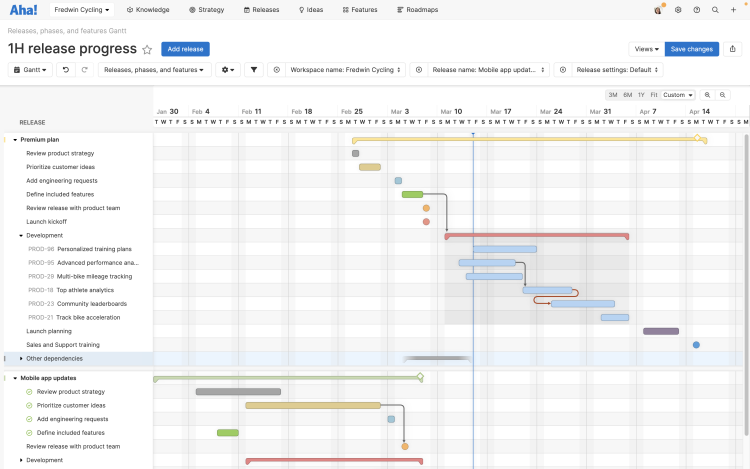
These are product releases organized in a Gantt chart view in Aha! Roadmaps.
5. Choose roadmap views
To get your product roadmap up and running, the final step is to visualize everything you have defined up to this point. Try roadmap templates or a roadmapping software tool to experiment with different roadmap views. Consider the following questions to help you decide what to include:
Who needs to see this product roadmap?
What is the most important information I want to convey?
Does my audience care more about the big picture or details?
Does my audience need to know general timing or exact dates?
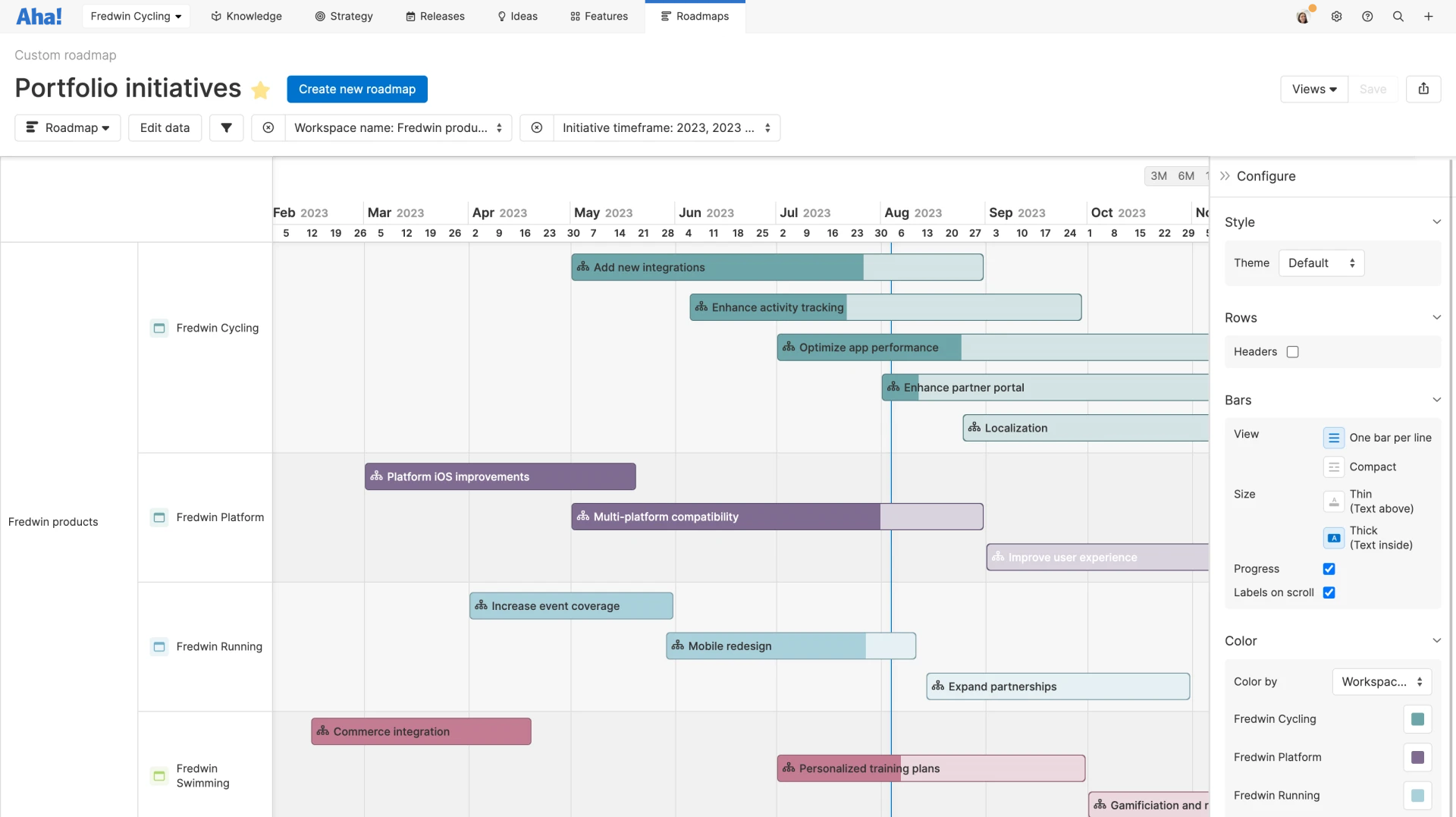
Build this product roadmap using Aha! Roadmaps.
Related guide: How to build a brilliant product roadmap
Additional product roadmap resources
Now that you know the basics, here are some extra tips and tools to help you build your best product roadmap.
Start by looking at some excellent examples for inspiration.
Explore best practices for product roadmapping to help frame your approach and make your roadmap visually appealing.
Experiment with different product roadmap styles using PowerPoint and Excel templates.
Try purpose-built product roadmapping software to build a custom roadmap that is dynamic and collaborative.
When your roadmap is ready, show it off. Create a product roadmap presentation to keep your stakeholders in the loop on progress and timing.
How product roadmaps are used by other teams
Outside of product management, other teams rely on product roadmaps for transparency, visualization, and communication. Here are a few examples of what different internal teams need to know about your product plans:
Customer support | The customer support team needs to be aware of the critical features or enhancements you are planning to deliver. This helps them keep customers informed and set better expectations. |
Engineering | Engineers need to understand the high-level strategy (the "why") along with the specifics of your releases, features, and requirements (the “when” and “what”). This helps them formulate the "how" — the development work required to build each feature. |
Leadership | Leadership teams and board members want to understand how your product plans align with the company vision, strategy, goals, and high-level business metrics. |
Marketing | The marketing team will want to see everything from your goals down to features — with an emphasis on overall benefits to customers. This helps them prepare for more impactful go-to-market campaigns. |
Sales | The sales team will be interested in any impact on customers — functionality details, timing, and why they should care about it. This helps to craft the right message for prospective customers. |
FAQs about product roadmaps
While product managers usually lead the process of creating the product roadmap, roadmapping is a cross-functional activity. Everyone on the broader team must understand what you are doing and why. This means that product managers gather information and input from both internal and external stakeholders — including executives, engineering, UX, marketing, sales, support, customers, and partners.
The time frame you show on your product roadmap depends on the level of detail you want to convey to your audience. For example, a product strategy roadmap for executives might show a timeline of a year or multiple years. A features roadmap for the product or engineering teams would show a shorter timeline of upcoming work over the next weeks, months, or quarters. What matters is that your product roadmap includes the key dates and deliverables for bringing lovable new offerings to customers.
A product roadmap is a visual timeline of your product vision and the work that the team will do to achieve that vision. A project plan, on the other hand, lays out the specifics of how the broader team will deliver a new customer experience. This includes the project goals, budget, milestones, tasks, and dates related to a product or feature launch. While product roadmaps show the high-level initiatives and upcoming releases or features, project plans show the tactical tasks and milestones needed to support the product roadmap.
